Abstract
1. Muscarinic receptors present in the human astrocytoma cell line 1321 N1 were characterized in radioligand binding studies and in functional studies of carbachol-stimulated phosphatidylinositol (PI) turnover. 2. In radioligand binding studies the muscarinic receptor in intact cells could be labelled using [3H]-N-methylscopolamine ([3H]-NMS) but not by [3H]-pirenzepine. In the intact cells these receptors displayed low pirenzepine affinity (pKi = 6.83) indicating that they were not of the M1 subtype. Furthermore, the 1321 N1 muscarinic receptors displayed low affinity for the two M2-cardiac selective ligands methoctramine (pKi = 5.82) and AF-DX 116 (pKi = 6.29). This pharmacology was consistent with the 1321 N1 cells containing a single population of muscarinic receptors that displayed a similar pharmacology to the M2-receptor present in exocrine gland tissue. 3. The M2-gland nature of the receptors was further indicated in the functional studies where antagonist affinities were determined from their ability to antagonize carbachol-stimulated PI turnover in 1321 N1 cells. pA2 values for pirenzepine (7.31), methoctramine (6.10) and AF-DX 116 (6.52) were similar to those determined in the binding studies. 4. From these studies we conclude that 1321 N1 astrocytoma cells contain an M2-gland muscarinic receptor which mediates muscarinic receptor-mediated stimulation of PI turnover in these cells.
Full text
PDF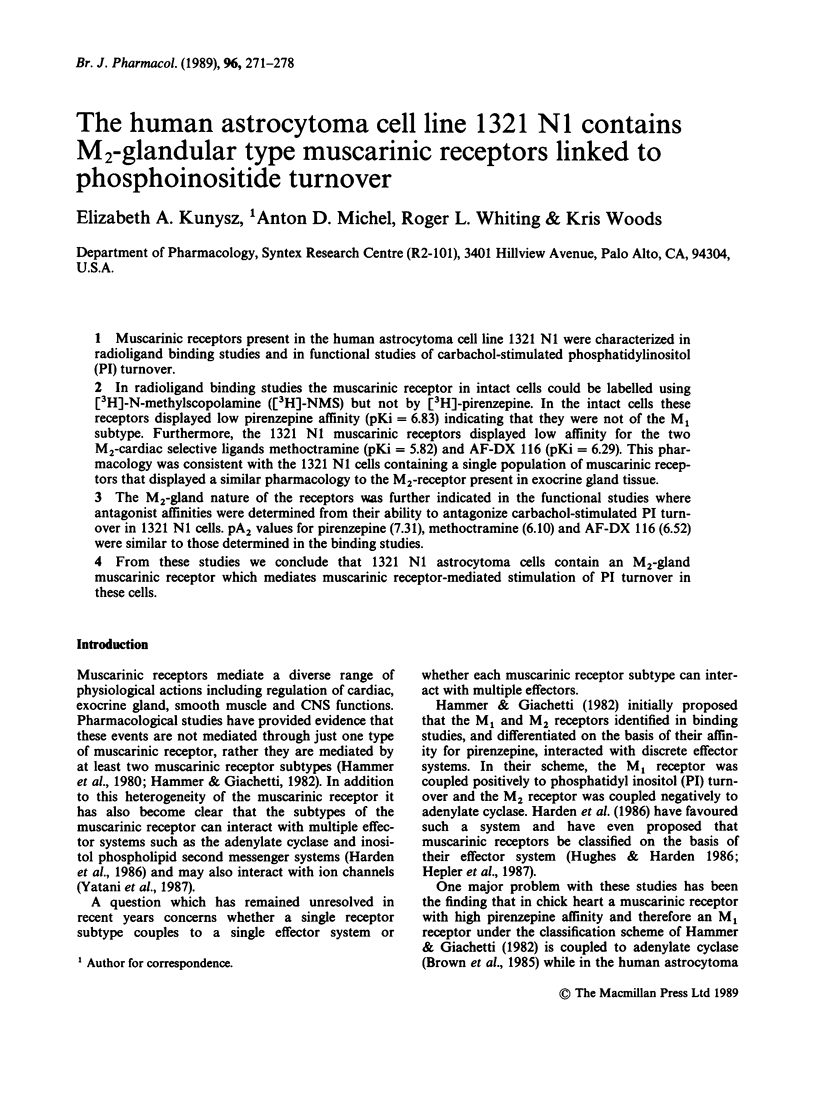
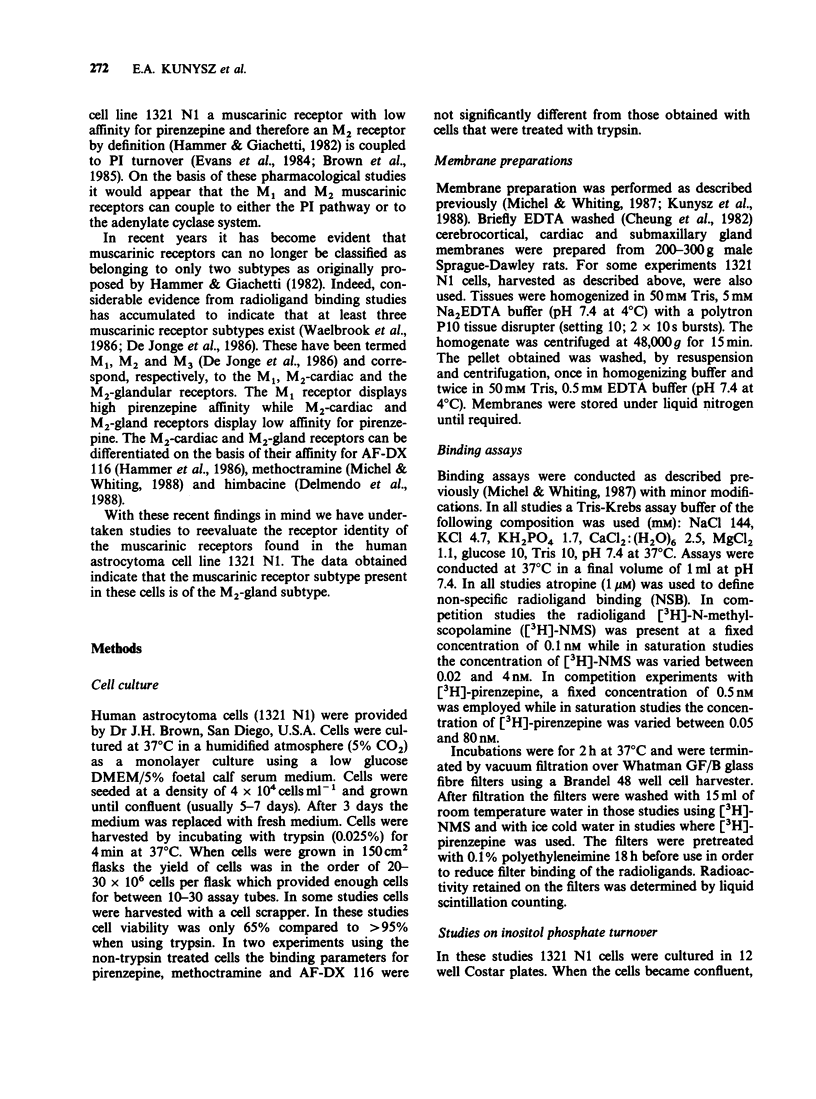
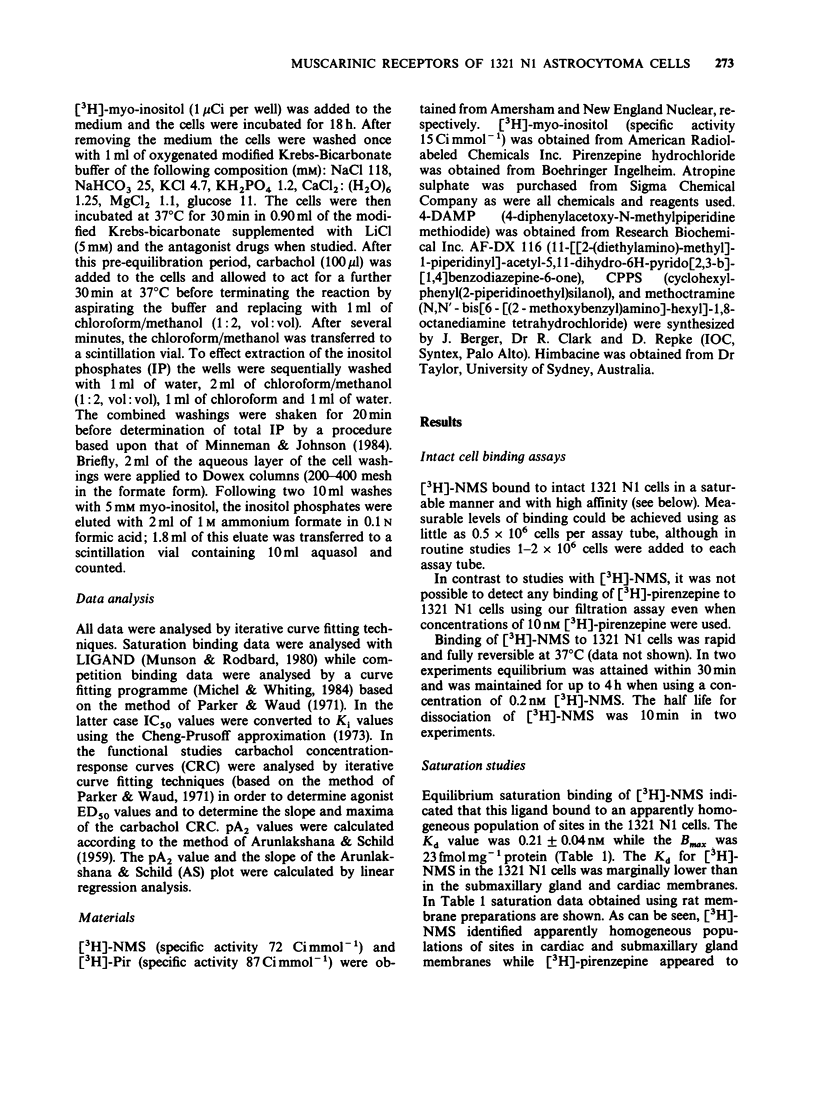
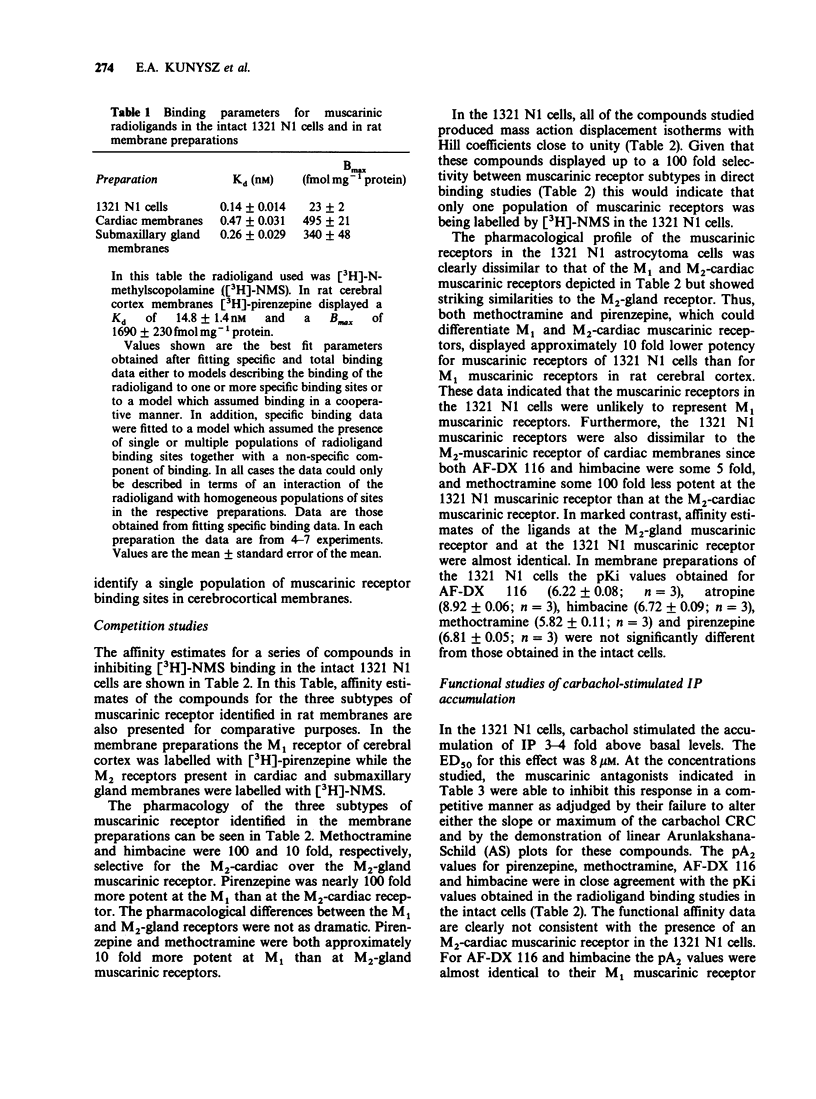
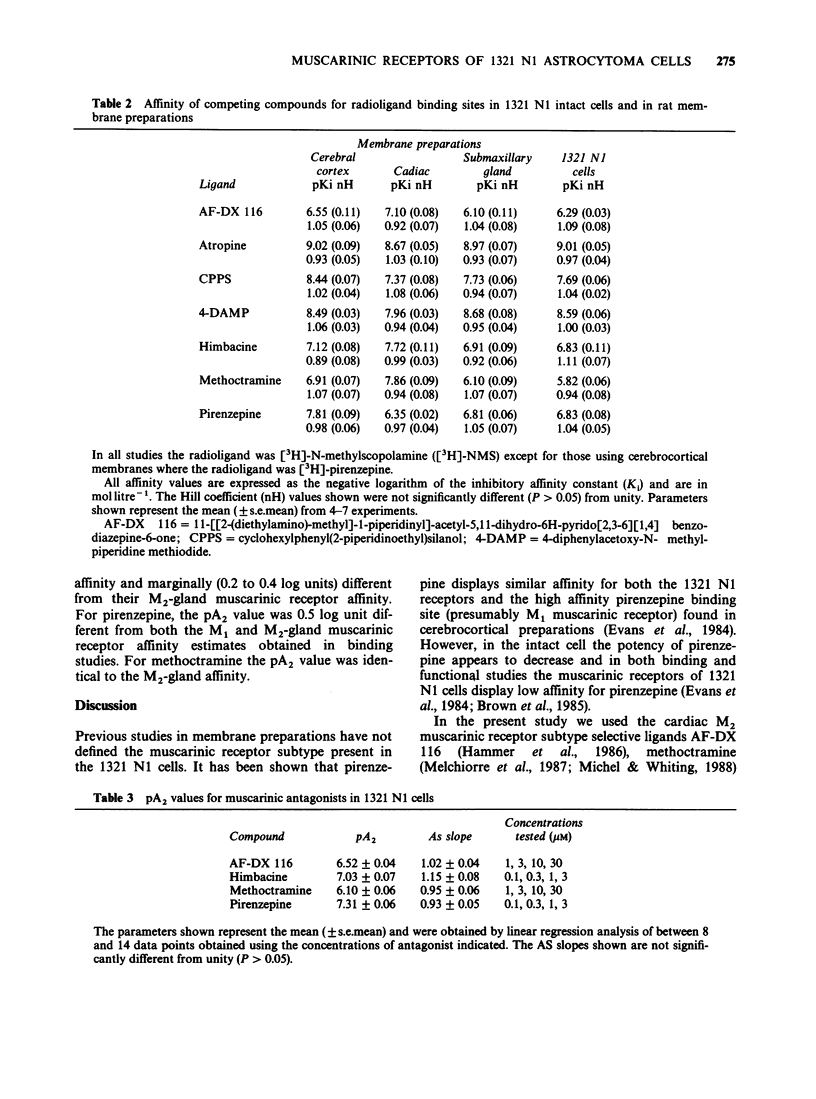
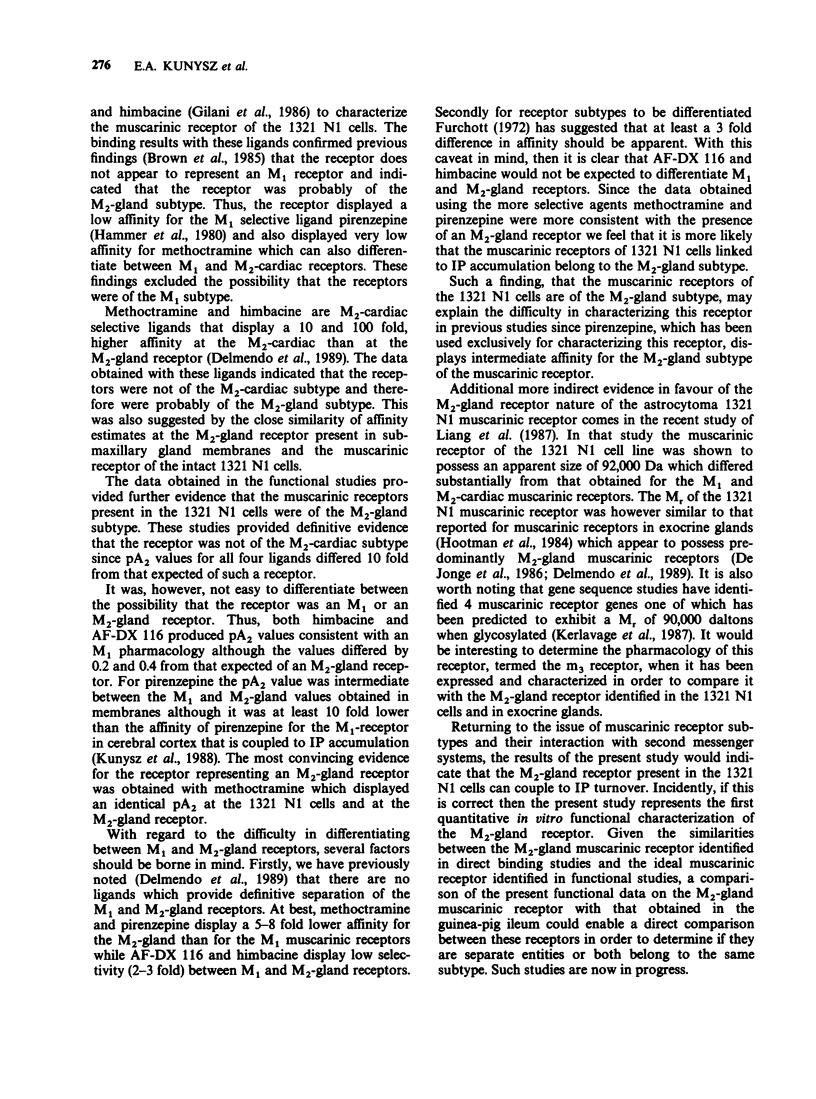
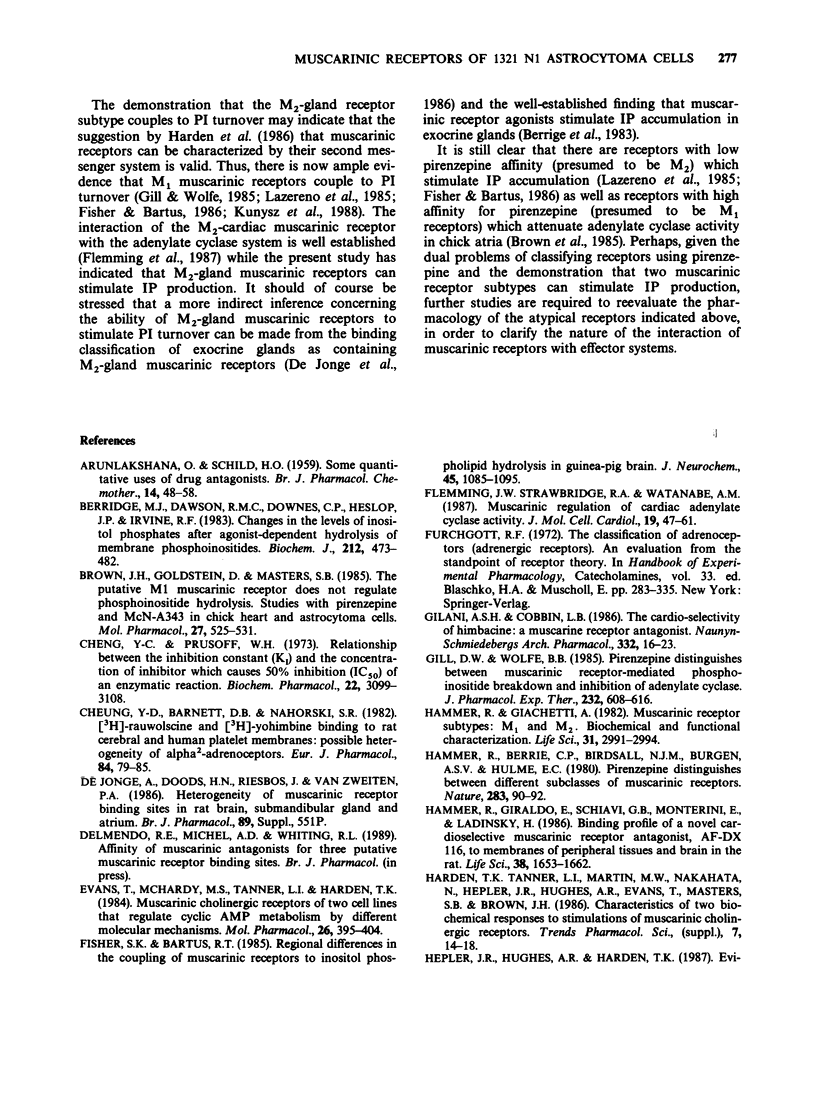
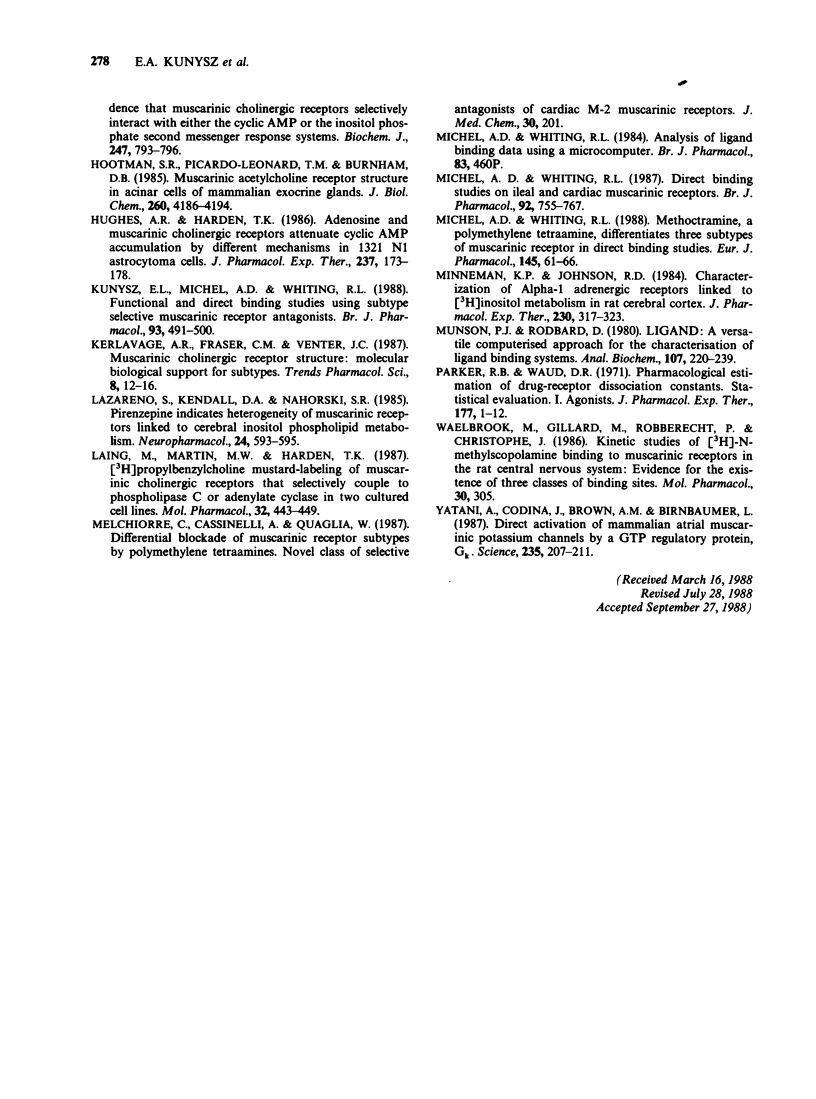
Selected References
These references are in PubMed. This may not be the complete list of references from this article.
- ARUNLAKSHANA O., SCHILD H. O. Some quantitative uses of drug antagonists. Br J Pharmacol Chemother. 1959 Mar;14(1):48–58. doi: 10.1111/j.1476-5381.1959.tb00928.x. [DOI] [PMC free article] [PubMed] [Google Scholar]
- Anwar-ul S., Gilani H., Cobbin L. B. The cardio-selectivity of himbacine: a muscarine receptor antagonist. Naunyn Schmiedebergs Arch Pharmacol. 1986 Jan;332(1):16–20. doi: 10.1007/BF00633191. [DOI] [PubMed] [Google Scholar]
- Berridge M. J., Dawson R. M., Downes C. P., Heslop J. P., Irvine R. F. Changes in the levels of inositol phosphates after agonist-dependent hydrolysis of membrane phosphoinositides. Biochem J. 1983 May 15;212(2):473–482. doi: 10.1042/bj2120473. [DOI] [PMC free article] [PubMed] [Google Scholar]
- Brown J. H., Goldstein D., Masters S. B. The putative M1 muscarinic receptor does not regulate phosphoinositide hydrolysis. Studies with pirenzepine and McN-A343 in chick heart and astrocytoma cells. Mol Pharmacol. 1985 May;27(5):525–531. [PubMed] [Google Scholar]
- Cheng Y., Prusoff W. H. Relationship between the inhibition constant (K1) and the concentration of inhibitor which causes 50 per cent inhibition (I50) of an enzymatic reaction. Biochem Pharmacol. 1973 Dec 1;22(23):3099–3108. doi: 10.1016/0006-2952(73)90196-2. [DOI] [PubMed] [Google Scholar]
- Cheung Y. D., Barnett D. B., Nahorski S. R. [3H]Rauwolscine and [3H]yohimbine binding to rat cerebral and human platelet membranes: possible heterogeneity of alpha 2-adrenoceptors. Eur J Pharmacol. 1982 Oct 15;84(1-2):79–85. doi: 10.1016/0014-2999(82)90159-5. [DOI] [PubMed] [Google Scholar]
- Evans T., Smith M. M., Tanner L. I., Harden T. K. Muscarinic cholinergic receptors of two cell lines that regulate cyclic AMP metabolism by different molecular mechanisms. Mol Pharmacol. 1984 Nov;26(3):395–404. [PubMed] [Google Scholar]
- Fisher S. K., Bartus R. T. Regional differences in the coupling of muscarinic receptors to inositol phospholipid hydrolysis in guinea pig brain. J Neurochem. 1985 Oct;45(4):1085–1095. doi: 10.1111/j.1471-4159.1985.tb05527.x. [DOI] [PubMed] [Google Scholar]
- Fleming J. W., Strawbridge R. A., Watanabe A. M. Muscarinic receptor regulation of cardiac adenylate cyclase activity. J Mol Cell Cardiol. 1987 Jan;19(1):47–61. doi: 10.1016/s0022-2828(87)80544-8. [DOI] [PubMed] [Google Scholar]
- Gil D. W., Wolfe B. B. Pirenzepine distinguishes between muscarinic receptor-mediated phosphoinositide breakdown and inhibition of adenylate cyclase. J Pharmacol Exp Ther. 1985 Mar;232(3):608–616. [PubMed] [Google Scholar]
- Hammer R., Berrie C. P., Birdsall N. J., Burgen A. S., Hulme E. C. Pirenzepine distinguishes between different subclasses of muscarinic receptors. Nature. 1980 Jan 3;283(5742):90–92. doi: 10.1038/283090a0. [DOI] [PubMed] [Google Scholar]
- Hammer R., Giachetti A. Muscarinic receptor subtypes: M1 and M2 biochemical and functional characterization. Life Sci. 1982 Dec 27;31(26):2991–2998. doi: 10.1016/0024-3205(82)90066-2. [DOI] [PubMed] [Google Scholar]
- Hammer R., Giraldo E., Schiavi G. B., Monferini E., Ladinsky H. Binding profile of a novel cardioselective muscarine receptor antagonist, AF-DX 116, to membranes of peripheral tissues and brain in the rat. Life Sci. 1986 May 5;38(18):1653–1662. doi: 10.1016/0024-3205(86)90409-1. [DOI] [PubMed] [Google Scholar]
- Hepler J. R., Hughes A. R., Harden T. K. Evidence that muscarinic cholinergic receptors selectively interact with either the cyclic AMP or the inositol phosphate second-messenger response systems. Biochem J. 1987 Nov 1;247(3):793–796. doi: 10.1042/bj2470793. [DOI] [PMC free article] [PubMed] [Google Scholar]
- Hootman S. R., Picado-Leonard T. M., Burnham D. B. Muscarinic acetylcholine receptor structure in acinar cells of mammalian exocrine glands. J Biol Chem. 1985 Apr 10;260(7):4186–4194. [PubMed] [Google Scholar]
- Hughes A. R., Harden T. K. Adenosine and muscarinic cholinergic receptors attenuate cyclic AMP accumulation by different mechanisms in 1321N1 astrocytoma cells. J Pharmacol Exp Ther. 1986 Apr;237(1):173–178. [PubMed] [Google Scholar]
- Kunysz E. L., Michel A. D., Whiting R. L. Functional and direct binding studies using subtype selective muscarinic receptor antagonists. Br J Pharmacol. 1988 Mar;93(3):491–500. doi: 10.1111/j.1476-5381.1988.tb10303.x. [DOI] [PMC free article] [PubMed] [Google Scholar]
- Lazareno S., Kendall D. A., Nahorski S. R. Pirenzepine indicates heterogeneity of muscarinic receptors linked to cerebral inositol phospholipid metabolism. Neuropharmacology. 1985 Jun;24(6):593–595. doi: 10.1016/0028-3908(85)90071-1. [DOI] [PubMed] [Google Scholar]
- Liang M., Martin M. W., Harden T. K. [3H]propylbenzilylcholine mustard-labeling of muscarinic cholinergic receptors that selectively couple to phospholipase C or adenylate cyclase in two cultured cell lines. Mol Pharmacol. 1987 Oct;32(4):443–449. [PubMed] [Google Scholar]
- Melchiorre C., Cassinelli A., Quaglia W. Differential blockade of muscarinic receptor subtypes by polymethylene tetraamines. Novel class of selective antagonists of cardiac M-2 muscarinic receptors. J Med Chem. 1987 Jan;30(1):201–204. doi: 10.1021/jm00384a034. [DOI] [PubMed] [Google Scholar]
- Michel A. D., Whiting R. L. Direct binding studies on ileal and cardiac muscarinic receptors. Br J Pharmacol. 1987 Dec;92(4):755–767. doi: 10.1111/j.1476-5381.1987.tb11379.x. [DOI] [PMC free article] [PubMed] [Google Scholar]
- Michel A. D., Whiting R. L. Methoctramine, a polymethylene tetraamine, differentiates three subtypes of muscarinic receptor in direct binding studies. Eur J Pharmacol. 1988 Jan 5;145(1):61–66. doi: 10.1016/0014-2999(88)90349-4. [DOI] [PubMed] [Google Scholar]
- Minneman K. P., Johnson R. D. Characterization of alpha-1 adrenergic receptors linked to [3H]inositol metabolism in rat cerebral cortex. J Pharmacol Exp Ther. 1984 Aug;230(2):317–323. [PubMed] [Google Scholar]
- Munson P. J., Rodbard D. Ligand: a versatile computerized approach for characterization of ligand-binding systems. Anal Biochem. 1980 Sep 1;107(1):220–239. doi: 10.1016/0003-2697(80)90515-1. [DOI] [PubMed] [Google Scholar]
- Parker R. B., Waud D. R. Pharmacological estimation of drug-receptor dissociation constants. Statistical evaluation. I. Agonists. J Pharmacol Exp Ther. 1971 Apr;177(1):1–12. [PubMed] [Google Scholar]
- Waelbroeck M., Gillard M., Robberecht P., Christophe J. Kinetic studies of [3H]-N-methylscopolamine binding to muscarinic receptors in the rat central nervous system: evidence for the existence of three classes of binding sites. Mol Pharmacol. 1986 Oct;30(4):305–314. [PubMed] [Google Scholar]
- Yatani A., Codina J., Brown A. M., Birnbaumer L. Direct activation of mammalian atrial muscarinic potassium channels by GTP regulatory protein Gk. Science. 1987 Jan 9;235(4785):207–211. doi: 10.1126/science.2432660. [DOI] [PubMed] [Google Scholar]


